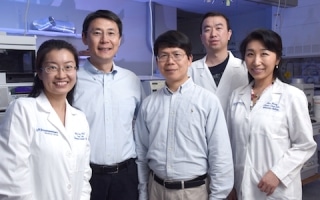Apr 25 2017
 UTSW researchers who developed a nanoparticle vaccine for cancer immunotherapy include (l-r) Drs. Min Luo, Jinming Gao, Zhijian "James" Chen, Zhaohui Wang, and Hua Wang. Credit: UT Southwestern Medical Center
UTSW researchers who developed a nanoparticle vaccine for cancer immunotherapy include (l-r) Drs. Min Luo, Jinming Gao, Zhijian "James" Chen, Zhaohui Wang, and Hua Wang. Credit: UT Southwestern Medical Center
A first-of-its-kind nanoparticle vaccine immunotherapy targeting several cancer varieties has been developed by researchers from UT Southwestern Medical Center.
This news nanovaccine s made up of tumor antigens – tumor proteins that are recognizable by the immune system – inside a synthetic polymer nanoparticle. Minuscule particulates, stimulating the immune system to mount an immune response, are delivered by nanoparticle vaccines. With this invention, the researchers aim at helping people’s own bodies fight cancer.
What is unique about our design is the simplicity of the single-polymer composition that can precisely deliver tumor antigens to immune cells while stimulating innate immunity. These actions result in safe and robust production of tumor-specific T cells that kill cancer cells.
Dr. Jinming Gao, Professor of Pharmacology and Otolaryngology, UT Southwestern Medical Centre
A study outlining this research, recently published online in Nature Nanotechnology, reported that the nanovaccine had anti-tumor efficacy in several tumor types in mice.
The research was carried by the joint effort between the laboratories of study senior authors Dr. Gao and Dr. Zhijian “James” Chen, Professor of Molecular Biology and Director of the Center for Inflammation Research. The Center was established in 2015 in order to analyze how the body senses infection and to create approaches that will help use this knowledge to develop new treatments for autoimmunity, immune disorders, and infection.
According to Dr. Gao , typical vaccines need immune cells to pick up tumor antigens in a “depot system” and then pass to the lymphoid organs for T cell activation. Instead, nanoparticle vaccines can pass directly to the body’s lymph nodes in order to activate tumor-specific immune responses.
For nanoparticle vaccines to work, they must deliver antigens to proper cellular compartments within specialized immune cells called antigen-presenting cells and stimulate innate immunity. Our nanovaccine did all of those things.
Dr. Zhijian Chen, Professor of Molecular Biology, UT Southwestern Medical Centre
In this case, the experimental UTSW nanovaccine functions by activating an adaptor protein known as STING, which in turn stimulates the immune defense system of the body to ward off cancer.
The scientists analyzed a wide range of tumor models in mice: colorectal cancer, melanoma, and HPV-related cancers of the cervix, anogenital regions,a nd neck. The nanovaccine slowed tumor growth in most cases and thus extended the animals’ lives.
Several other vaccine technologies have been employed in cancer immunotherapy. But these technologies are generally complex, comprising of multiplex biological stimulants or live bacteria, Dr. Gao said. This complex nature can result in costly production, and in some cases, lead to immune-related toxicities in patients.
Dr. Gao further stated that the field of nanoparticle vaccines has grown and gained intense interest from industry and academia in the past decade due to the increased understanding of polymeric drug delivery and the emergence of new nanotechnology tools.
Recent advances in understanding innate and adaptive immunity have also led to more collaborations between immunologists and nanotechnologists. These partnerships are critical in propelling the rapid development of new generations of nanovaccines.
Dr. Zhijian Chen, Professor of Molecular Biology, UT Southwestern Medical Centre
Currently, the team is working with physicians at UT Southwestern to study clinical testing of the STING-activating nanovaccines for different cancer indications. Incorporating nanovaccines with radiation or other immunotherapy strategies such as “checkpoint inhibition” can indeed further augment their anti-tumor effectiveness.
Study lead authors from UT Southwestern were Dr. Min Luo, research scientist; Dr. Hua Wang, Instructor of Molecular Biology; and Dr. Zhaohui Wang, postdoctoral fellow. Other UTSW researchers involved included graduate students Yang Li, Chensu Wang, Haocheng Cai, and Mingjian Du; Dr. Gang Huang, Instructor of Pharmacology and in the Simmons Comprehensive Cancer Center; Dr. Xiang Chen, research specialist; Dr. Zhigang Lu, Instructor of Physiology; Dr. Matthew Porembka, Assistant Professor of Surgery and a Dedman Family Scholar in Clinical Care; Dr. Jayanthi Lea, Associate Professor of Obstetrics and Gynecology and holder of the Patricia Duniven Fletcher Distinguished Professorship in Gynecological Oncology; Dr. Arthur Frankel, Professor of Internal Medicine and in the Simmons Comprehensive Cancer Center; and Dr. Yang-Xin Fu, Professor of Pathology and Immunology, and holder of the Mary Nell and Ralph B. Rogers Professorship in Immunology.
The National Institutes of Health, the Cancer Prevention and Research Institute of Texas, a UTSW Small Animal Imaging Resource grant and a Simmons Comprehensive Cancer Center support grant supported this work.